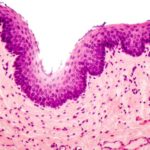Epithelial Tissue
The epithelium is a sheet of aggregated cells of similar type that covers body surfaces, lines hollow organs or modified to form glands or neuroepithelium.
General Features of Epithelium
- It may originate from all three embryonic germ layers (ectoderm, mesoderm and endoderm).
- It is composed of high number of closely applied cells with very little intercellular substances.
- It is separated from the underlying connective tissue by a basement membrane.
- It is avascular, blood and lymph vessels do not penetrate the basement membrane. Thus, it receives its nutritional support by diffusion.
- The epithelial cells have high capacity for regeneration.
The epithelium can change from one form to another in a process called metaplasia.
- It performs many functions such as protection, secretion, excretion, absorption and sensory reception.
Epithelium
The epithelium is a sheet of cells that covers body surface, lines hollow organs or modified to form glands and neuroepithelium.
What is the most difficult part in this section? send email to:drhany@mansvet.com
Objectives:
After the completion of this chapters you will be able to:
- enumerate the general epithelial features
- classify epithelium
- enumerate types and give examples
- illustrate the different types of simple epithelium.
- illustrate the different types of stratified epithelium.
- classify glands
- describe the structure of myo- and neuroepithelium.
Quiz
- Enumerate the features of epithelium?
- Classy epithelium and describe the histological structure of each type?
- Enumerate basal, lateral and apical modifications?
- Classify glands and describe the structure of each type?
